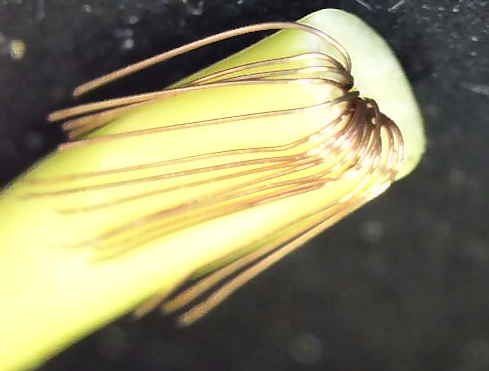In a previous post a distortion producing alligator clip was unearthed. In this post high resistance test leads are discovered. These are generic banana plug to alligator clips (Vellman TLM3) that were purchased from Jameco:

which are obvious generic made in China ones but from a reputable supplier versus the ebay/alibaba mystery stuff. Using them with a 3,3V bench supply to power a circuit drawing about 150 mA it was noticed that the supply voltage was low at the board by about 250 mV vs the bench supply setting.
After poking around, a quick check of the test leads showed they measured about 0.8 ohms from the plug to clip. This is thin wire, around 26 AWG (spec’d as 16 x 0.1mm) but that wouldn’t explain the measured resistance in a 90 cm lead (about 0.1 ohms would be expected). Pulling back the clip boot the following connection:

Bending back the tangs holding the insulation exposes the wire:

The wire is just jammed in under the insulation and not secured with a gas tight crimp nor soldered in.
Soldering the connection and reassembling, the resistance was still around 0.8 ohms. The banana plug end is overmolded so can’t be taken apart. Checking the resistance to the mid point of the test lead showed about 0.4 ohms to each end. Grabbing two other unmodified test lead all showed the same issue. Therefor it’s not the connection but the wire itself.
Sacrificing a lead and carefully removing the insulation, a 80 cm piece of an individual strand measures a little under 11 ohms for an 80 cm length, or about 13.5 ohms/meter, which also checks with the measured resistance for 16 strands. However a 0.1mm strand is about the same as 38 AWG, which is 2 ohms/meter, or about 1.6 ohms is what we would expect to measure in a single 80 cm long strand.
Something is certainly not right – either the strands are thinner than spec’d (I measure a little more than 3 mils +/- 1 mil with a manual caliper, so this does not explain it) or they’re not copper (really tough to believe) ?
Regardless, the leads are useless for hooking up to a power supply. Luckily there’s enough parts on hand to make some real ones with 16 AWG wire that measure as close to zero as a standard ohm meter can get, and with those the voltage drop between the supply and circuit is solved.
